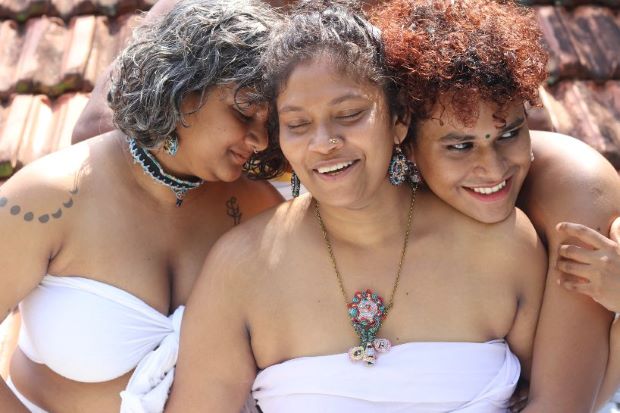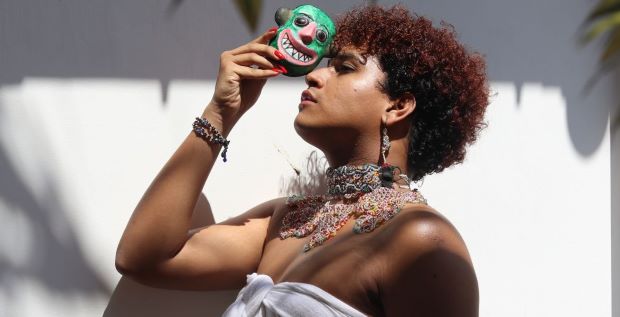Reviving traditional performance attire with a gender-inclusive spin
By Sohini Dey
The works of up and coming Sri Lankan artist Chathuri Nissansala share a distinctive style—disfigured idols and other items collected from various locations of the country that has witnessed decades of insurgency and violence. Nissansala restores these found objects—often considered to be ill omen—using colourful beadwork and intricate embroidery, into memorials of healing and hope. Her works have been exhibited widely, including in India, but the 29-year-old artist from Colombo has extended her artistic practice in a new direction this year: jewellery making.
Kāgul, conceptualized by Nissansala, is a new label offering handmade beaded and embroidered jewellery. The artist draws inspiration from costume and jewellery traditions of southern Sri Lanka’s ritualistic performances, learnt from her mentor Somapala Pothupitiya, which she has used in her art.
Pothupitiya belongs to the Navadanne community that traditionally made costumes for such ceremonial performances. With Kāgul, these traditions find an expression outside the performance space, in everyday wear. “I wanted to make it contemporary, and common—so that more people would start wearing them,” Nissansala says.
Beading new traditions

Southern Sri Lanka is home to multi-layered performance practices with distinctive forms in the Bentara, Matara and Raigama districts; the Pothupitiya family is from Matara. Their attire and adornments are not merely for performance, but also imbued with symbolic meaning as they were meant to be worn during ritualistic performances such as the Thovil (an exorcist ritual also known as the ‘Devil Dance’) and curative healing practices. The ornaments are elaborate and heavy—and include apparel and adornments such as necklaces, waistbands or the kāgul meaning a crown, which gives Nissansala’s label its name. The costume traditions are influenced not only by indigenous rituals but also colonial influences—in their introduction of jackets, frills in shirts and the silhouettes of some jewels.
The tradition of costume making for such performances is rapidly dwindling, and Somapala Pothupitiya is one of the last purveyors of this knowledge system. With Kāgul, Nissansala—an alumnus of Karnataka Chitrakala Parishath, Bengaluru, and Maharaja Sayajirao University of Baroda—takes a revivalist approach. She has been learning costume making from Somapala at Mullegama Art Centre in Sri Lanka—an institution established by the latter’s son, acclaimed visual artist Pala Pothupitiya—and applying it as leitmotifs in her art.
Kāgul’s designs are primarily crafted using beadwork on a base of textiles. Nissansala recreates the geometric and floral patterns from traditional designs, but reinvents the proportion and forms. “Some of the traditional designs are quite big and heavy for us to carry. There are certain rules and regulations of how the pieces should be worn—I did not want to use the original designs, but started deciphering the techniques.”
Kāgul’s debut collection, titled ‘Awaken Dreamers’, includes necklaces and chokers, earrings, bracelets and anklets. The designs carry meaning in their use of colours and motifs. For instance, the use of the punkalasa (meaning “the pot of plenty”) with triple lotus flower buds in a necklace symbolizes prosperity while the abundant use of red is a sign of the mythological figure Pattini who is considered one of Sri Lanka’s guardian deities. Some of the designs are modular—bracelets that can double as neckpieces. The label currently runs as an Instagram shop, with prices ranging from under ₹10,000 for delicate danglers to around ₹30,000 for a statement choker. All the pieces are made to order and in small batches; the label also ships to India. “I want to move away from the idea of mass production because I am creating these as art,” she adds.
Stories of Inclusivity

Nissansala is among few women who have learnt the traditional costume making of Matara; the crafts are learnt by men who are also among the dominant performers. The presence of women in the practice is only in anecdotes and conversations; not in representative images and literature which the artist notes is often written from Eurocentric perspectives. “My mentor showed me how gender and sexuality is highlighted in symbolic ways, through patterns and costume-making,” she says. “I wanted to make Kāgul more inclusive and create a dialogue for women and queer artists.” All jewellery from Kāgul is gender-fluid, an inclusive quality also expressed in the label’s campaign stills.
Not limited only to southern textile jewellery traditions, Nissansala hopes to add newer techniques and interpretations to the label’s vocabulary. “I am hoping to use another embroidery form, from the northern hilly regions of Sri Lanka,” she says. “I find the craft interesting because it is a community of women who are carrying on the tradition.” Now working on the label’s second collection, scheduled to drop by the middle of this year, she hopes to involve more crafts and collaborators in the project. “I’ve seen a lot of interest for apprenticeships. Many are also coming up with their own designs,” the artist adds.
– thevoiceoffashion.com/Pictures Chathuri Nissansala



Comments are closed, but trackbacks and pingbacks are open.